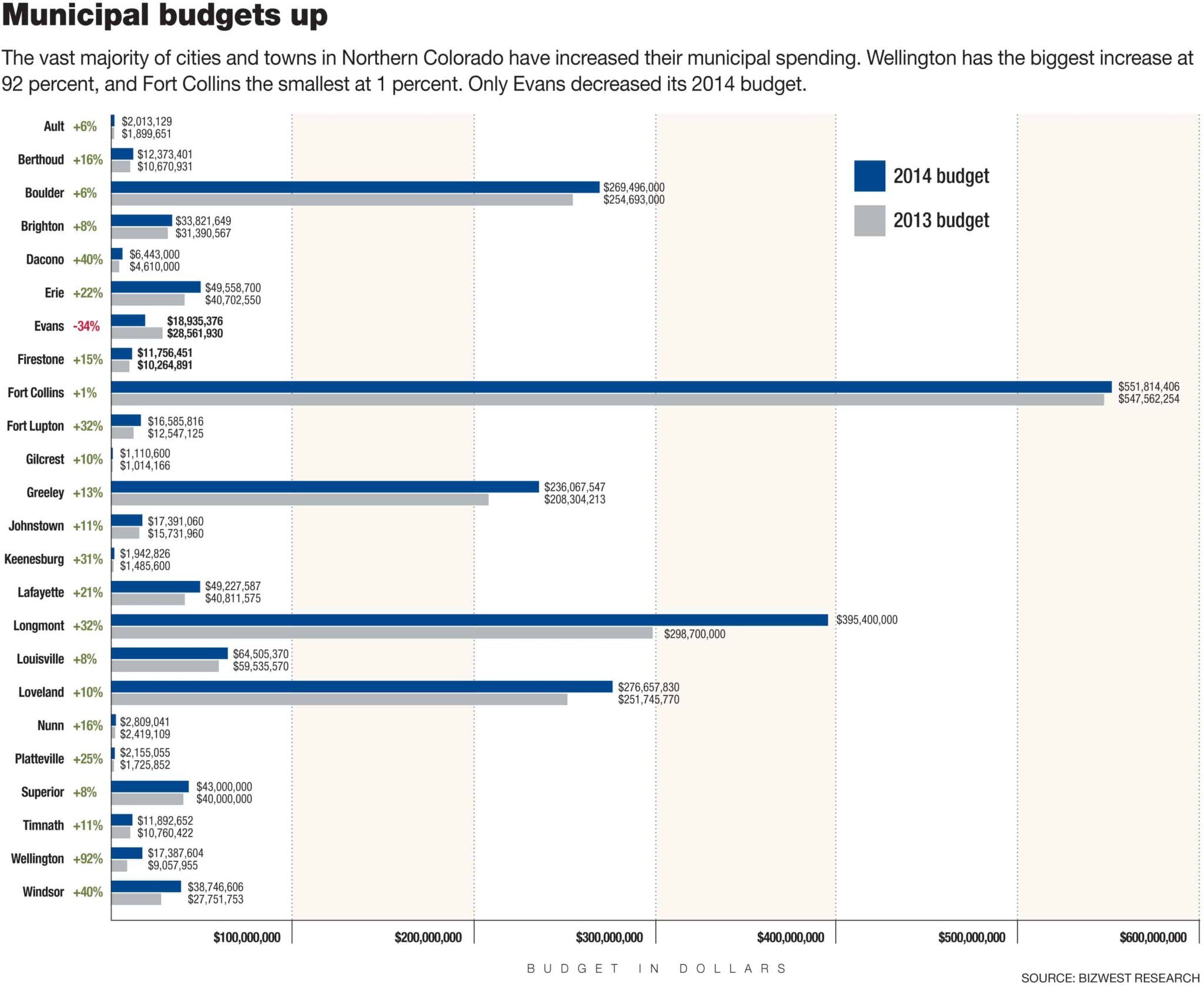Recovery spurs cities’ spending surge

Municipalities across the Boulder Valley and Northern Colorado, thanks in large part to the economic recovery, are spending roughly $2.1 billion in 2014, up about $200 million, or 11 percent, over last year.
The surge in spending is true across the board, from larger cities such as Louisville, Longmont and Loveland to small towns such as Wellington, according to an analysis by BizWest.
After years of recession-driven budget cuts, 25 cities are loosening the purse strings this year, with some seeing budgets that are more than 50 percent higher than in 2008.
SPONSORED CONTENT
People Powered: Preparing Longmont Businesses for Economic Success
Longmont Chamber and FNBO present People Powered on April 24, 2024, aiming to inform business owners about workforce development, housing, and transportation issues.
Louisville has increased its expenditures dramatically since the recession, up almost 50 percent from $29 million in 2008 to $43 million in 2013, according to the city’s budget documents. This year it is spending about $64.5 million, up from $59.5 million in 2013.
“In part due to the floods of last September, the city has been working on some big projects, including the general street reconstruction, McCaslin (Boulevard)/U.S. (Highway) 36 interchange, sludge treatment and handling, golf course reconstruction and city services facility,” said Kevin Watson, finance director of the city of Louisville.

On a recent weekday morning, Jessi Hersey, 24, was working as a cashier at The Singing Cook in downtown Louisville. She has lived in Louisville for 20 years, having moved there when she was 4 years old. She said the public projects she’s witnessed, including the massive road construction, are important, but she would like the city to spend its new cash on faster flood repairs and shelters for abused women and the homeless.
“I think we should really focus on the holes that are still left from the flood that haven’t been touched,” she said. “I also would like to see the city build a safehouse for women and an actual homeless shelter.”
James Kwuun, owner of Assorted Goods & Candy in Louisville, moved from New York about five years ago, and said he has seen property and sales taxes rising since then.
“I think in the past five years the city has grown dramatically,” Kwuun said. “We used to be a small town, but now we’re getting a lot more economic growth. There is more development and more students here.”
Like Louisville, Longmont has increased its spending dramatically since the recession, laying out $230.5 million last year, up 26 percent from the $182.4 million it was able to spend in 2008.
“I would say that the city is able to budget more expenditures than in recession years,” said Bryan Bartow, the city’s accounting and budget analyst, “but, because of the flood in September 2013, a large portion of the increased budget is for repair and maintenance of infrastructure damaged by the flood.”
Bartow said that “although the city is recovering from the recession, there are some revenues, such as property tax, that have not come back to pre-recession levels yet.”
Loveland has increased its spending 29 percent since the recession, from $184.2 million in 2008 to $238.3 million in 2013, according to the city’s budget data.
“We are able to spend more in the recent years than in 2008 and 2009 because our revenues have returned to pre-recession levels,” said Matthew Elliott, the city’s budget analyst.
But the city with the biggest spending plan this year, on a percentage basis, is also one of the smallest: Wellington, just northeast of Fort Collins, population 6,514.
Wellington will spend up to $17.4 million this year, 92 percent more than the $9 million it spent in 2013, depending on construction progress on two major projects, a new city park and a waste water treatment plant needed to serve a booming residential sector.
In fact, Wellington issued 140 residential building permits in 2013, up from 13 in 2008.
Fort Collins and Boulder, on the other hand, have posted only modest spending increases.
Fort Collins has bumped outlays by just 4 percent, from $524.7 million in 2008 to $547.2 million in 2013, according to the data.
Expenditures in Boulder also have come back since the recession, with spending rising 13 percent since 2008.
Municipalities across the Boulder Valley and Northern Colorado, thanks in large part to the economic recovery, are spending roughly $2.1 billion in 2014, up about $200 million, or 11 percent, over last year.
The surge in spending is true across the board, from larger cities such as Louisville, Longmont and Loveland to small towns such as Wellington, according to an analysis by BizWest.
After years of recession-driven budget cuts, 25 cities are loosening the purse strings this year, with some seeing budgets that are more than 50 percent higher than in 2008.
Louisville has increased its…
THIS ARTICLE IS FOR SUBSCRIBERS ONLY
Continue reading for less than $3 per week!
Get a month of award-winning local business news, trends and insights
Access award-winning content today!

